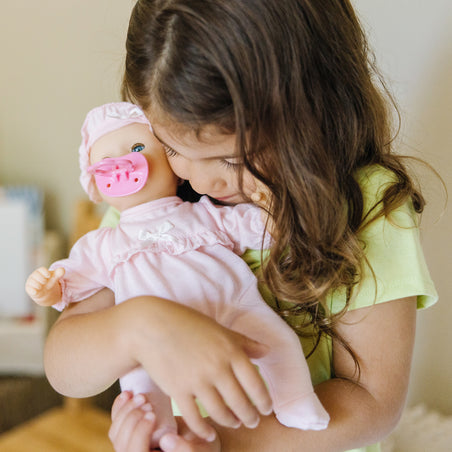If you talk to any child therapist, you’ll hear how they use play to help children cope and learn through challenges. They may use puppets or dolls, board games or drawing to tap into how a child is feeling, or even just to make kids feel comfortable enough that they can talk openly. Why is this?
Young children don’t think in abstract concepts the way teens and adults do. They can’t read self-help books, write reflections in a journal, or analyze their situation with a therapist.
But they do play through their conflicts and emotions, and make up stories to help themselves feel in control. If your family is going through a particularly rough time, or even just a rough day, set aside a little more time for your child to play it out. Take out some stuffed animals, costumes, or crayons, and see what types of stories might bubble to the surface. Here are a few ideas on how to scaffold these types of play experiences:

-
Replay life with characters
Kids’ magical thinking means that they project their thoughts and experiences into their favorite characters — be it a stuffed animal, a favorite TV or book character, or an imaginary friend. Use this to your advantage when trying to help your child cope. After a stressful experience, have your child’s favorite stuffed animal, figurine, or puppet go through something similar. See what your child says or how they react to seeing the character go through it (“oh, Foxy is really angry about moving to a new home — what should he do?”) -
Put them in a position of power
Stressful events often put us in a place of powerlessness. But, play gives kids power — the power to decide what happens next, how to help others, and who they want to be. Use play to flip the power tables: going to the dentist office? Offer your child a pretend dentist kit to act out with. Seeking a chance to act brave? Have them pretend to be a firefighter or explorer. And don’t direct play too much — to help your child feel in control, let them make it up — just offer hints when needed. -
Let them draw
Drawings offer an interesting window into emotions for some children. For children who have the motor abilities to draw on their own, just put out some paper and crayons/markers and ask them to draw how their brain feels, the worst part of their day, or their biggest wish. For younger kids, caregivers can draw and narrate as they go, either drawing a scenario that just took place or taking direction from the child. It can be silly or serious, but the most important thing is the child “seeing” their experience retold sensitively by the parent. Either way, don’t judge! Kids sometimes draw aggressive things or show themselves as the “bad guy” — the most important part is letting them know they can talk about it with you.
Once again, this type of therapeutic play does not have to be perfect. The real healing comes from the fact that you are making space and time to talk about difficult things with your child. Carving out time for play helps us not revert to the easy avoidance/distraction strategies of TV and video games. Telling stories and feeling secure in relationships are how we heal, and play is the number one way that children do both.












